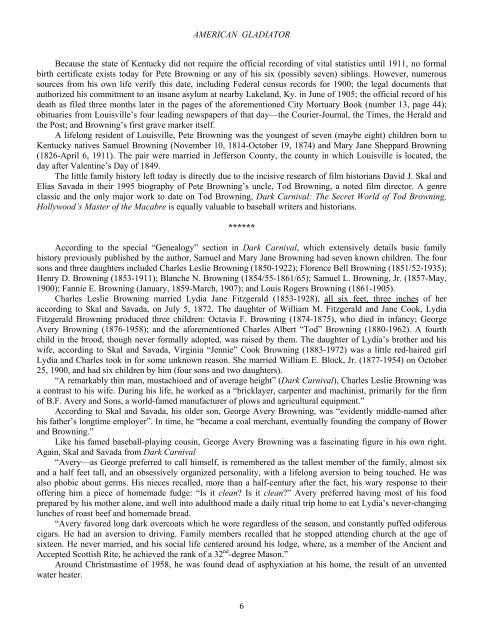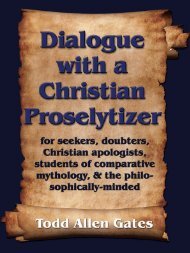AMERICAN GLADIATOR: The Life And Times Of ... - The Book Locker
AMERICAN GLADIATOR: The Life And Times Of ... - The Book Locker
AMERICAN GLADIATOR: The Life And Times Of ... - The Book Locker
Create successful ePaper yourself
Turn your PDF publications into a flip-book with our unique Google optimized e-Paper software.
<strong>AMERICAN</strong> <strong>GLADIATOR</strong><br />
Because the state of Kentucky did not require the official recording of vital statistics until 1911, no formal<br />
birth certificate exists today for Pete Browning or any of his six (possibly seven) siblings. However, numerous<br />
sources from his own life verify this date, including Federal census records for 1900; the legal documents that<br />
authorized his commitment to an insane asylum at nearby Lakeland, Ky. in June of 1905; the official record of his<br />
death as filed three months later in the pages of the aforementioned City Mortuary <strong>Book</strong> (number 13, page 44);<br />
obituaries from Louisville’s four leading newspapers of that day—the Courier-Journal, the <strong>Times</strong>, the Herald and<br />
the Post; and Browning’s first grave marker itself.<br />
A lifelong resident of Louisville, Pete Browning was the youngest of seven (maybe eight) children born to<br />
Kentucky natives Samuel Browning (November 10, 1814-October 19, 1874) and Mary Jane Sheppard Browning<br />
(1826-April 6, 1911). <strong>The</strong> pair were married in Jefferson County, the county in which Louisville is located, the<br />
day after Valentine’s Day of 1849.<br />
<strong>The</strong> little family history left today is directly due to the incisive research of film historians David J. Skal and<br />
Elias Savada in their 1995 biography of Pete Browning’s uncle, Tod Browning, a noted film director. A genre<br />
classic and the only major work to date on Tod Browning, Dark Carnival: <strong>The</strong> Secret World of Tod Browning,<br />
Hollywood’s Master of the Macabre is equally valuable to baseball writers and historians.<br />
******<br />
According to the special “Genealogy” section in Dark Carnival, which extensively details basic family<br />
history previously published by the author, Samuel and Mary Jane Browning had seven known children. <strong>The</strong> four<br />
sons and three daughters included Charles Leslie Browning (1850-1922); Florence Bell Browning (1851/52-1935);<br />
Henry D. Browning (1853-1911); Blanche N. Browning (1854/55-1861/65); Samuel L. Browning, Jr. (1857-May,<br />
1900); Fannie E. Browning (January, 1859-March, 1907); and Louis Rogers Browning (1861-1905).<br />
Charles Leslie Browning married Lydia Jane Fitzgerald (1853-1928), all six feet, three inches of her<br />
according to Skal and Savada, on July 5, 1872. <strong>The</strong> daughter of William M. Fitzgerald and Jane Cook, Lydia<br />
Fitzgerald Browning produced three children: Octavia F. Browning (1874-1875), who died in infancy; George<br />
Avery Browning (1876-1958); and the aforementioned Charles Albert “Tod” Browning (1880-1962). A fourth<br />
child in the brood, though never formally adopted, was raised by them. <strong>The</strong> daughter of Lydia’s brother and his<br />
wife, according to Skal and Savada, Virginia “Jennie” Cook Browning (1883-1972) was a little red-haired girl<br />
Lydia and Charles took in for some unknown reason. She married William E. Block, Jr. (1877-1954) on October<br />
25, 1900, and had six children by him (four sons and two daughters).<br />
“A remarkably thin man, mustachioed and of average height” (Dark Carnival), Charles Leslie Browning was<br />
a contrast to his wife. During his life, he worked as a “bricklayer, carpenter and machinist, primarily for the firm<br />
of B.F. Avery and Sons, a world-famed manufacturer of plows and agricultural equipment.”<br />
According to Skal and Savada, his older son, George Avery Browning, was “evidently middle-named after<br />
his father’s longtime employer”. In time, he “became a coal merchant, eventually founding the company of Bower<br />
and Browning.”<br />
Like his famed baseball-playing cousin, George Avery Browning was a fascinating figure in his own right.<br />
Again, Skal and Savada from Dark Carnival<br />
“Avery—as George preferred to call himself, is remembered as the tallest member of the family, almost six<br />
and a half feet tall, and an obsessively organized personality, with a lifelong aversion to being touched. He was<br />
also phobic about germs. His nieces recalled, more than a half-century after the fact, his wary response to their<br />
offering him a piece of homemade fudge: “Is it clean? Is it clean?” Avery preferred having most of his food<br />
prepared by his mother alone, and well into adulthood made a daily ritual trip home to eat Lydia’s never-changing<br />
lunches of roast beef and homemade bread.<br />
“Avery favored long dark overcoats which he wore regardless of the season, and constantly puffed odiferous<br />
cigars. He had an aversion to driving. Family members recalled that he stopped attending church at the age of<br />
sixteen. He never married, and his social life centered around his lodge, where, as a member of the Ancient and<br />
Accepted Scottish Rite, he achieved the rank of a 32 nd -degree Mason.”<br />
Around Christmastime of 1958, he was found dead of asphyxiation at his home, the result of an unvented<br />
water heater.<br />
6
















